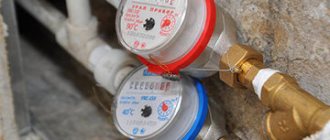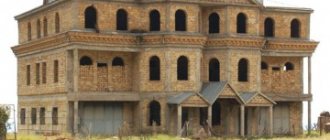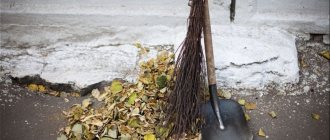Reasons for registering an electric meter
Electricity metering devices (MU) are reliable devices. The inter-verification period is 10-20 years. It depends on the type of meter. However, situations may arise in which it is necessary to replace the device before the end of its service life and register it.
These may be the following reasons:
- The expiration date has come to an end.
- The meter has failed. A self-propelled gun appeared or the readings stopped changing.
- After replacing the existing meter with a modern metering device.
- Changing the location of the electricity meter.
- There was a need for separate accounting of detached buildings. This situation arises when renting out premises for individual entrepreneurs, legal entities or individuals. In this case, a new electric meter is additionally installed.
When choosing a meter, take into account the place of its operation. Not every device has the ability to work outdoors at sub-zero temperatures.
The passport indicates the temperature indicators at which the operation of the equipment is permitted. Now the rules require that in a private house, an outdoor version of the introductory box be mounted on the wall of the building, fence or additional support.
The figure below shows a separate metering board, which doubles as an input panel on the site of a private house.
Our certificates
Cost of services
| HEATING INSTALLATION | ||
| Unit measurements | Cost in Moscow in rubles. | |
| Turnkey heating system installation | sq.m. | 520 |
| Installation/dismantling of a heating radiator on a ready-made supply line | PC. | 1 620 |
| Installation of a heating radiator (with shut-off and control valves and connection to the pipeline). | PC. | 3 420 |
| Installation of a non-standard heating radiator (cast iron, design cast iron, design tubular). | PC. | 4 370 |
| Installation of an underfloor heating convector (with shut-off and control valves and connections). | PC. | 5 420 |
| Installation of a thermostat on a heating device | PC. | 245 |
| Laying pipelines along the floor and walls d 16-32 mm. | m. linear | 130 |
| Laying lines along the floor and walls d 40-50 mm. | m. linear | 170 |
| Laying pipelines along the floor and walls d 63-110 mm. | m. linear | 200 |
| Laying lines along the ceiling d 16 - 32 mm. | m. linear | 255 |
| Laying lines along the ceiling d 40 - 50 mm. | m. linear | 390 |
| Laying lines along the ceiling d 63 - 110 mm. | m. linear | 645 |
| Installation of pipe thermal insulation for pipes d 32 mm. | m. linear | 28 |
| Assembly and installation of a heating manifold with connection | PC. | 4 560 |
| Installation of a manifold cabinet (the built-in cabinet is mounted in a prepared niche) | PC. | 1 190 |
| Electric boiler installation | PC. | 7 130 |
| Installation of a single-circuit gas wall-mounted boiler | PC. | 7 410 |
| Installation of a wall-mounted double-circuit gas boiler | PC. | 8 550 |
| Installation of a floor-standing gas boiler up to 50 kW | PC. | 10 260 |
| Installation of a floor-standing gas boiler from 50 to 90 kW | PC. | 15 390 |
| Installation of a floor-standing gas boiler from 90 to 200 kW | PC. | 20 240 |
| Installation of solid fuel boiler up to 50 kW | PC. | 11 690 |
| Installation of a solid fuel boiler from 50 to 90 kW | PC. | 13 680 |
| Installation of a pellet boiler up to 50 kW | PC. | 15 390 |
| Installation of a pellet boiler from 50 to 90 kW | PC. | 18 810 |
| Installation of a diesel boiler (fuel tank, fuel pump, filters) | PC. | 12 830 |
| Installation of hydraulic separator | PC. | 3 040 |
| Installation of the main collector | PC. | 4 940 |
| Installation of a direct pump group | PC. | 3 420 |
| Installation of a mixing pump group | PC. | 4 370 |
| Installation of an expansion tank for a heating system | PC. | 1 710 |
| Installation of a safety group for a heating system | PC. | 1 810 |
| Installation of a circulation pump with an oblique filter and check valve | PC. | 2 850 |
| Installation of a circulation pump with bypass | PC. | 3 800 |
| Installation of a heat accumulator up to 400 liters | PC. | 8 650 |
| Installation of a heat accumulator from 400 to 1000 liters | PC. | 12 830 |
| Installation of boiler room automation | PC. | 8 550 |
| Organization of replenishment of the heating system | PC. | 1 330 |
| Filling the system with coolant | PC. | 2 850 |
| Pressure testing of the heating system | PC. | 3 420 |
| INSTALLATION OF WARM FLOOR | ||
| Installation of heated floors | sq.m. | 420 |
| Installation of insulation with bosses and damper tape | sq.m. | 130 |
| Installation of roll insulation, mesh and damper tape | sq.m. | 180 |
| Assembly and installation of the mixing unit | PC. | 5 420 |
| Installation of the mixing unit assembly | PC. | 2 470 |
| Installation and assembly of a heated floor collector with connection | PC. | 4 560 |
| Installation of a room heating floor controller for one circuit | PC. | 2 700 |
| Installation of heated floor risers | PC. | 2 660 |
| Installation of the control module | PC. | 2 850 |
| Installation of a room thermostat with electrical wiring | PC. | 1 430 |
| Installation of heat distribution plates | PC. | 45 |
| CHIMNEY INSTALLATION | ||
| Installation of a single-wall chimney d 60 - 250 mm. | m. linear | 720 |
| Installation of insulated / coaxial chimney d 60 - 250 mm. | m. linear | 1 380 |
| Connection to a single-wall chimney d 60 - 250 mm. | PC. | 720 |
| Connection to an insulated / coaxial chimney d 60 - 250 mm. | PC. | 1 380 |
| Connection to an existing chimney | PC. | 2 090 |
| WATER SUPPLY INSTALLATION | ||
| Installation of a water supply point | dot | 1 380 |
| Installation of water supply risers | m. linear | 1 660 |
| Laying water supply pipes up to 32 mm | m. linear | 130 |
| Laying main water supply pipes in thermal insulation up to d 32 mm. with fasteners | m. linear | 160 |
| Laying an external water supply line with power supply to the pump (without excavation work) | m. linear | 330 |
| Installation of a water supply system collector with connection to the mains and supply pipeline | PC. | 3 940 |
| Installation of overhead distribution cabinet (built-in is installed in a prepared niche) | PC. | 1 190 |
| Pressure reducer installation | PC. | 570 |
| Installation and configuration of a leakage protection system | PC. | 5 320 |
| Installation of a coarse filter (FGO) | PC. | 570 |
| Installation of a self-cleaning filter with a pressure gauge | PC. | 1 140 |
| Installation of terminals for heated towel rails | PC. | 2 850 |
| Bandaging the riser for a heated towel rail with bypass | PC. | 3 800 |
| Installation of a hydraulic accumulator for a water supply system | PC. | 2 470 |
| Installation of a recirculation system for each group | PC. | 3 420 |
| Installation of a bypass line for water treatment | PC. | 2 380 |
| Installation of a pump with a check valve and a filter for the supply circuit for the boiler | PC. | 2 190 |
| Installation of a pumping station | PC. | 4 560 |
| Well pump installation | PC. | 5 700 |
| Installation of a well pump with a head | PC. | 7 130 |
| Installation of shut-off valves at consumers | PC. | 255 |
| Installation of a boiler safety group | PC. | 1 330 |
| Installation of a thermostatic valve for domestic hot water | PC. | 3 420 |
| Installation of instantaneous water heater up to 8 kW | PC. | 3 330 |
| Installation of a storage boiler up to 100 l. | PC. | 3 900 |
| Installation of a storage boiler from 80 to 200 l. | PC. | 6 460 |
| Installation of an indirect heating boiler up to 150 l. | PC. | 7 410 |
| Installation of an indirect heating boiler 150 - 300 l. | PC. | 8 650 |
| Installation of an indirect heating boiler 300 - 600 l. | PC. | 12 830 |
| Installation of a geyser | PC. | 5 130 |
| Installation of caisson (without excavation) | PC. | 6 650 |
| Installation of a storage plastic tank up to 2 cubic meters. | PC. | 5 600 |
| SEWER INSTALLATION | ||
| Installation of sewage point up to 2 meters | PC. | 720 |
| Installation of a sewer riser | m. linear | 860 |
| Laying sewerage on the floor and walls, up to d 50 mm. | m. linear | 140 |
| Laying sewerage on the floor and walls, up to d 150 mm. | m. linear | 285 |
| Laying sewerage on the ceiling, up to d 50 mm. | m. linear | 670 |
| Laying sewerage on the ceiling, up to d 150 mm. | m. linear | 950 |
| Installation of a sewer check valve | PC. | 860 |
| Installation of sewage pumping station | PC. | 3 900 |
| Installation of a sewer aerator | PC. | 255 |
| Installation of a square sewer drain | PC. | 900 |
| Installation of a slotted sewer drain | PC. | 2 000 |
| Installation of sewer inspection | PC. | 860 |
| Installation of TOPAS septic tank with sand bunding | PC. | 20 900 |
| Installation of sewer rings | PC. | 4 750 |
| Laying the PND-32 pipeline with insulation without excavation work | m. linear | 285 |
| Laying a PVC-110 pipeline with insulation without excavation work | m. linear | 380 |
| Laying PVS cable without excavation work | m. linear | 190 |
| Installation of a drainage pump | PC. | 3 330 |
| AUTOMATION OF ENGINEERING SYSTEMS | ||
| Installation and configuration of the controller (1-2 control outputs) | PC. | 3 420 |
| Installation of a boiler and heating control controller | PC. | 11 120 |
| Installation and adjustment of a mechanical thermostat | PC. | 950 |
| Installation and adjustment of an electric thermostat | PC. | 1 330 |
| Installation and adjustment of a weekly thermostat | PC. | 1 800 |
| Installation of a thermostat for a trench convector with forced convection | PC. | 3 420 |
| Installation of a pressure switch with alarm | PC. | 3 140 |
| Installation of a pump pressure switch | PC. | 1 800 |
| Organization of protection of the dry passage of the nose | PC. | 3 420 |
| Installation of a boiler outdoor temperature sensor | PC. | 1 800 |
| Installation of a boiler temperature sensor | PC. | 950 |
| Installation of three-way valve servomotor | PC. | 950 |
| Installation of commutator servo drive | PC. | 950 |
| Installation of boiler room electrical panel | PC. | 4 750 |
| Installation of a flow switch | PC. | 3 040 |
| Installation of frequency automation on the pump | PC. | 3 040 |
| Electrical connection of the boiler and circulation pump | PC. | 1 140 |
| Installation of pump automation | PC. | 2 000 |
| Laying a heating cable without excavation work | PC. | 2 850 |
| Electrical connection of the solenoid valve | PC. | 950 |
| Electrical connection of the temperature relay | PC. | 950 |
| Assembly of the automation control panel | PC. | 42 750 |
| PLUMBING WORK | ||
| Installation installation | PC. | 3 420 |
| Installation of hydromassage panel | PC. | 5 130 |
| Installation of a steel / acrylic bathtub | PC. | 3 700 |
| Installation of a cast iron bathtub | PC. | 4 700 |
| Installing a whirlpool bath | PC. | 7 600 |
| Installation and assembly of a shower cabin | PC. | 5 700 |
| Installation and assembly of a shower cabin with hydromassage | PC. | 6 900 |
| Washing machine/dishwasher installation | PC. | 1 140 |
| Installing a water heated towel rail without changing the connection diagram | PC. | 1 620 |
| Installation of an electric heated towel rail | PC. | 1 140 |
| Installation of an overhead sink (without mixer and siphon) | PC. | 670 |
| Installing a sink on brackets | PC. | 950 |
| Installation of a sink with a “Tulip” stand | PC. | 1 430 |
| Installation of a sink with a cabinet-underframe “Moidodyr” | PC. | 2 850 |
| Installation of toilet, bidet | PC. | 2 570 |
| Toilet assembly | PC. | 480 |
| Installation of a wall-mounted mixer with eccentrics | PC. | 1 140 |
| Installing a shower rod | PC. | 760 |
| Installation of a shower column (rain shower) | PC. | 2 380 |
| Installation of a concealed mixer | PC. | 4 750 |
| Installing a faucet on a washbasin | PC. | 950 |
| Installation of bidet mixer with hygienic shower | PC. | 1 430 |
| Mixer assembly | PC. | 240 |
| Installation of corner tap with reflector | PC. | 330 |
| Installing a siphon on a sink | PC. | 480 |
| Installing a siphon on a bathtub with piping | PC. | 670 |
| Installing a siphon on a bathtub (automatic piping) | PC. | 860 |
| Installing a siphon on a bathtub (copper, steel piping) | PC. | 950 |
| Installation of toilet corrugation | PC. | 670 |
| Siphon assembly | PC. | 190 |
| Installation of a food waste shredder | PC. | 1 900 |
| Installation of a fine filter (AQUOPHOR, GEYSER) | PC. | 2 280 |
| Installation of a household reverse osmosis purification system | PC. | 3 900 |
| Replacing filter cartridges | PC. | 950 |
| Installation of flexible liner | PC. | 140 |
| Sealing seams with silicone | PC. | 180 |
| Punching a hole in the sink for the faucet | PC. | 350 |
| REPLACEMENT / INSTALLATION / MAINTENANCE OF METERING DEVICES | ||
| Checking the water meter | PC. | 1000 |
| Replacing a water meter (work) | PC. | 1000 |
| Installation of a water meter (work) | PC. | 1 430 |
| Commissioning of a DHW and cold water metering device | PC. | 1 400 |
| Sealing of the metering device | PC. | 500 |
| Replacing the connecting kit (American) with a check valve | PC. | 670 |
| Ball valve installation | PC. | 330 |
| Installing/Replacing a Check Valve | PC. | 570 |
| Cleaning the coarse filter (FGO) | PC. | 460 |
| Eliminating leaks (replacing gaskets) | PC. | 380 |
| Installing an aerator to save water | PC. | 280 |
| REPAIR AND SERVICE | ||
| Diagnosis of boiler, heating and water supply system malfunctions | PC. | 2 850 |
| Boiler, heating and water supply system repair (simple breakdown) | PC. | 4 750 |
| Repair of boiler, heating and water supply systems (complex breakdown) | PC. | 7 600 |
| Replacing the expansion tank | PC. | 4 280 |
| Replacing the circulation pump | PC. | 3 800 |
| Replacing a three-way mixer | PC. | 4 750 |
| Replacing the servo | PC. | 2 850 |
| Replacement of air vent, valve, pressure gauge, thermometer, thermomanometer | PC. | 860 |
| Replacement of ball valve, oblique filter, check valve | PC. | 950 |
| Draining and filling coolant into the heating system | PC. | 7 600 |
| Flushing the heating system | PC. | 17 100 |
| Flushing the boiler heat exchanger | PC. | 6 200 |
| Boiler service | PC. | 8 550 |
| DISMANTLING WORK | ||
| Dismantling the boiler without removal | PC. | 2 380 |
| Dismantling the boiler without removal | PC. | 2 380 |
| Dismantling a heating radiator without removal | PC. | 480 |
| Dismantling of pipes d 15 - 25 mm. | PC. | 100 |
| Dismantling of sewer pipes d 50 mm. | PC. | 380 |
| Caulking a cast iron sewer pipe | PC. | 1 140 |
| Dismantling a steel / acrylic bathtub without removal | PC. | 950 |
| Dismantling a cast iron bathtub without removal | PC. | 1 140 |
| Dismantling a shower cabin without removal | PC. | 1 430 |
| Dismantling the sink/sink with underframe | PC. | 570 |
| Dismantling the toilet | PC. | 480 |
| Removing a washing machine/dishwasher | PC. | 480 |
| Removing the heated towel rail | PC. | 480 |
| Removing the shower panel with hydromassage | PC. | 670 |
| Removing the sink/sink/tub faucet | PC. | 380 |
| Removing the sink/sink siphon | PC. | 280 |
| Removing the bathtub trim | PC. | 380 |
| DESIGN | ||
| Drawing up a room plan | sq.m.. | 30 |
| Thermal engineering calculation (floor height up to 4 m) | sq.m. | 30 |
| House heating project up to 100 m2 | PC. | 14 250 |
| House heating project from 100 to 500 m2 | sq.m. | 85 |
| Project for heating a house from 500 m2 | sq.m. | 70 |
| Design of a water heated floor system | sq.m. | 75 |
| Water supply project up to 100 m2 | PC. | 11 400 |
| Water supply and sewerage project for a house from 100 to 500 m2 | sq.m. | 75 |
| Water supply and sewerage project for a house from 500 m2 | sq.m. | 65 |
| Integrated design of home systems | sq.m. | 120 |
| DRILLING WALLS FOR PIPES | ||
| Concrete (diameter up to 25 mm.) | m.p. | 570 |
| Brick (diameter up to 25 mm.) | m.p. | 380 |
| Gypsum (diameter up to 25 mm.) | m.p. | 280 |
| Concrete (diameter from 25 mm to 50 mm) | m.p. | 760 |
| Brick (diameter from 25 mm to 50 mm) | m.p. | 570 |
| Gypsum (diameter from 25 mm to 50 mm) | m.p. | 380 |
| General types of work | ||
| Pipe cutting: polypropylene, metal plastic, PVC sewer* | PC. | 50 |
| Installation of metal and rubber clamps* | PC. | 110 |
| Installation of angles, couplings, tees - one connection* | PC. | 180 |
| Removing sewer clogs | PC. | 1900 |
| Cleaning a solo elevator | PC. | 3800 |
| Fixing a leak under the bathtub | PC. | 1140 |
| Eliminating siphon leaks under the sink, cleaning the siphon | PC. | 670 |
| Installing the comb on the brackets | PC. | 760 |
| Additional thread cutting | PC. | 140 |
| Installation of a sanitary hatch 40cm*40cm with site preparation | PC. | 2380 |
| Other works | ||
| Works, services not included in the price list | one hour | 600 |
| Visit of a specialist to prepare an estimate | one | 0 |
| Removal of technical waste and pipes | 0 | |
Requirements for metering devices
The choice of device should be approached responsibly. It is necessary to select the type of device that is in the list of the state register of measuring instruments. In this case, the electricity meter must be approved by the federal executive body for technical regulation and metrology.
PU must meet the operating conditions at the installation site. Have an error of no more than 2%. The owner must decide what power will be installed in the premises.
Select an electric meter by type of design:
- Mechanical single-phase. These devices are not currently produced, but you can still find them in the retail chain. You should avoid purchasing such devices. They are morally outdated.
- Electronic devices. Compact, inexpensive PU. Meet all necessary requirements. Accuracy class 1-0.5%. Both single-phase and three-phase options are available. They have the ability to transmit data over communication lines or via the Internet. They can be single-tariff or multi-tariff.
The owner chooses which electric meter to purchase. But it should be taken into account that the equipment must be connected to the network by an electrician from a specialized organization that has certificates for performing similar work. If the owner makes the connection himself, he will be fined for illegal connection.
But, before calling a specialist to register the meter, it is necessary to inspect the input panel and machines. Bring equipment into compliance with standards. If the connection is made at a summer cottage, it is recommended to purchase a ready-made mounted panel. This will save the owner from unnecessary expenses.
Time to put the electric meter into operation
Based on the current rules for the provision of utility services to citizens, the consumer must send an application to fix the date and deadline for putting the new meter into operation.
The appeal must be considered by the energy saving company as the executor.
If the time indicated by the consumer in the application is busy and it is problematic to allocate it, the executor may send an appeal to the applicant with a request to revise the date.
Consideration of an application from a citizen should not last more than three days. In addition, it is prohibited to offer the applicant a date that postpones the requested date by more than 15 days.
It is important to pay attention! If the contractor does not appear at the site within the time period established in the application or he cannot offer an alternative date in less than 15 days, then the device will be considered put into operation.
The registration date will be the exact day on which the citizen submitted the application. All indications for payment of electricity consumption will be counted from this moment. If the energy saving company continues to charge payments according to average consumption standards, the user has the right to file a complaint with the Housing Inspectorate.
Documents required for registration
After connecting the control unit to the power grid, which is carried out by a specialized organization, the owner submits an application to the power supply. It is important to note that the company must have a license to carry out such work.
Before the visit, he collects a package of documents, which includes:
- A statement that is written directly at the energy sales office. A sample is provided upon request. It contains information: last name, first name, patronymic of the owner, passport and contact information. Indicate the desired date of registration. Type of device, serial number of the electric meter. They are indicated in the passport for the electric meter. Data from the company that connected the device to the network. And the readings at the time of connection;
- Copies of documents on the basis of which the form is filled out are attached to the application.
What if I want a smart electricity meter right now?
If your electric meter was installed recently and there are still 10-16 years left until the end of the calibration interval, it makes sense to check with the energy sales company when they plan to replace the meters. Energy engineers may be planning automation in the near future, then you will just need to wait a little until it’s your turn to reach your apartment.
If you plan to install smart meters only after the verification interval has expired, and you want to get rid of the need to transfer readings every month, it makes sense to install a smart electric meter at your own expense.
Metering device registration deadlines
After submitting the application, registration of the electric meter must be completed no later than 30 days from the date of submission of the application.
If the inspector does not come within 15 days after the appointed time, it is considered that the electricity meter has been put into operation.
The owner should know that after installing the seal, a report must be drawn up. When replacing an old meter with a new one, the report indicates the latest readings of the previous device. The act must be registered in a single center.
Who pays for the meter replacement?
The cost of installing and registering a new meter depends on the type of property ownership. If the apartment is privatized, the owner is obliged to maintain electrical appliances. All expenses are paid by the property owner.
For municipal housing, work is performed not at the expense of the owner, but of the person renting the apartment. It is he who will have to purchase a new meter and bear the costs of installation and registration.
We recommend: How to correctly calculate gas payments
Registration procedure
The installed electric meter must be registered (registered) with the energy supply company. The registration procedure is carried out in the following order:
- the owner applies to the energy supplier with an application to register the meter;
- within a week from the date of filing the application, the organization makes adjustments to the state register;
- at the next stage, a resolution on registering a new meter is signed;
- the applicant is issued a certificate for the purchase of the device;
- Based on the document received, an electric meter is purchased.
Complete with the purchased product, the owner receives a device passport issued by the manufacturer. The owner is obliged to keep the certificate and passport of the meter issued by the resource supplier for the entire period of operation of the device, since this documentation indicates the main technical characteristics of the product.
Can the management company pay for the installation of smart water, gas or heat meters?
Maybe if such a decision is made by a general meeting of home owners, but in practice such situations are rare. The initiator of consideration of the issue of automation at a general meeting can be the management company itself or the residents of the apartment building.
A positive decision will certainly be beneficial to the management company, because it will reduce both the amount of operational work for collecting evidence and the number of defaulters. In turn, residents will be freed from the need to submit their testimony monthly and pay for unreliable neighbors. But in any case, residents will finance the installation of smart appliances, so the decision to use them within an entire house or community is always made collectively.










